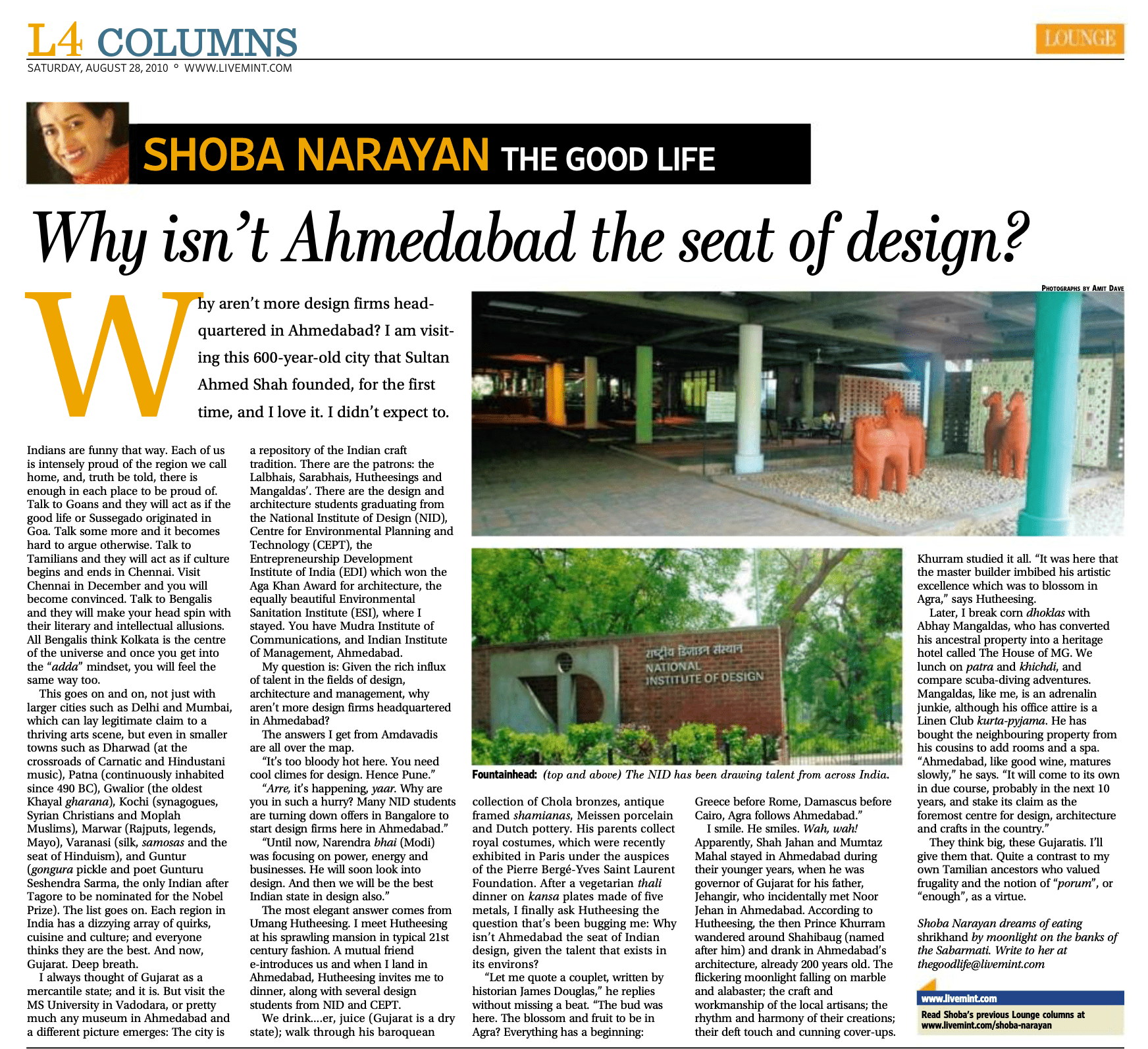Why aren’t more design firms headquartered in Ahmedabad?
4 min read .

I am visiting this 600-year-old city that Sultan Ahmed Shah founded, for the first time, and I love it. I didn’t expect to.
Indians are funny that way. Each of us is intensely proud of the region we call home, and, truth be told, there is enough in each place to be proud of. Talk to a Goan and they will act as if the good life or Sussegado originated in Goa. Talk some more and it becomes hard to argue otherwise. Talk to a Tamilian and they will act as if culture begins and ends in Chennai. Visit Chennai in December and you will become convinced. Talk to a Bengali and they will make your head spin with their literary and intellectual allusions. All Bengalis think Kolkata is the center of the universe and once you get into the ‘adda’ mindset, you will feel the same way too. This goes on and on, not just with larger cities like Delhi and Mumbai, which can lay legimitate claim to a thriving arts scene, but even in smaller towns like Dharwad (at the crossroads of Carnatic and Hindustani music), Patna (continuously inhabited since 490 B.C.), Gwalior (the oldest khayal gharana), Cochin (synagogues, Syrian Christians and Mopla Muslims), Marwar (Rajputs, legends, Mayo), Benaras (silk, samosas and the seat of Hinduism), and Guntur (gongura pickle and poet Gunturu Seshendra Sarma, the only other Indian after Tagore to be nominated for the Nobel prize). The list goes on. Each region in India has a dizzying array of quirks, cuisine and culture; and everyone thinks they are the best. And now, Gujarat. Deep breath.
I always thought of Gujarat as a merchantile state; and it is. But visit the MS University in Baroda, or pretty much any museum in Ahmedabad and a different picture emerges: the city is a repository of the Indian craft tradition. There are the patrons: the Lalbhais, Sarabhais, Hutheesings and Mangaldas’. There are the design and architecture students graduating from the National Institute of Design (NID), Center for Environmental Planning and Technology (CEPT), the Entepreneurship Development Institute (EDI) which won the Aga Khan Award for architecture, the equally beautiful Environmental Sanitation Institute (ESI) where I stayed. You have Mudra Institute of Communications, and IIM-A. My question is: given the rich influx of talent in the fields of design, architecture, and management, why aren’t more design firms headquartered in Ahmedabad?
The answers I get from Amdavadis are all over the map.
“It’s too bloody hot here. You need cool climes for design. Hence Pune.”
“Arre, it’s happening, yaar. Why are you in such a hurry? Many NID students are turning down offers in Bangalore to start design firms here in Ahmedabad.”
“Until now, Narendra-bhai (Modi) was focusing on power, energy and businesses. He will soon look into design. And then we will be the best Indian state in design also.”
The most elegant answer comes from Umang Hutheesing. I meet Hutheesing at his sprawling mansion in typical 21st century fashion. A mutual friend e-introduces us and when I land in Ahmedabad, Hutheesing invites me to dinner, along with several other design students from NID and CEPT.
We drink vodka; walk through his baroquean collection of Chola bronzes, antique framed shamianas, Meissen porcelein and Dutch pottery. His parents collect royal costumes, which were recently exhibited in Paris under the auspices of the Pierre Berger-Yves St. Laurent Foundation. After a vegetarian thali dinner on kansa plates made of five metals, I finally ask Hutheesing the question that’s been bugging me: why isn’t Ahmedabad the seat of Indian design, given the talent that exists in its environs?
“Let me quote a couplet, written by historian James Douglas,” he replies without missing a beat. “The bud was here. The blossom and fruit to be in Agra. Everything has a beginning: Greece before Rome, Damacus before Cairo, Agra follows Ahmedabad.”
I smile. He smiles. Wah, wah! Apparently, Shah Jahan and Mumtaz Mahal stayed in Ahmedabad during their younger years, when he was Governor of Gujarat for his father, Jehangir, who incidentally met Noor Jehan in Ahmedabad. According to Hutheesing, the then Prince Khurram wandered around Shahibag (named after him) and drank in Ahmedabad’s architecture, already 200 years old. The flickering moonlight falling on marble and alabaster; the craft and workmanship of the local artisans; the rhythm and harmony of their creations; their deft touch and cunning cover-ups. Khurram studied it all. “It was here that the master builder imbibed his artistic excellence which was to blossom in Agra,” says Hutheesing.
Later, I break corn dhoklas with Abhay Mangaldas, who has converted his ancestral property into a heritage hotel called House of MG. We lunch on patra and khichdi, and compare scuba-diving adventures. Mangaldas, like me, is an adrenaline junkie, although his office attire is a Linen Club kurta-pyjama. He has bought the neighbouring property from his cousins to add rooms and a spa. “Ahmedabad, like good wine, matures slowly,” he says. “It will come to its own in due course, probably in the next ten years, and stake its claim as the foremost centre for design, architecture and crafts in the country.”
They think big, these Gujaratis. I’ll give them that. Quite a contrast to my own Tamilian ancestors who valued frugality and the notion of “porum,” or “enough,” as a virtue.
Shoba Narayan dreams of eating shrikhand by moonlight on the banks of the Sabarmathi.
First published on: 26 Aug 2010, 09:10 PM IST






Leave A Comment